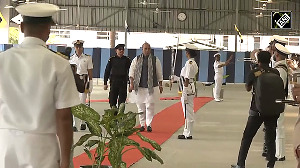Textile barons and apparel exporters do not share the government's optimism that their sector's exports will touch $50 billion by 2010, up from $14 billion of the present.
"Though the government has come out with the $ 50-billion target, it may be difficult to achieve it since the government has not come out with a concrete plan," said Indo Rama Synthetics (India) Managing Director OP Lohia.
"The target is unrealistic. We will have to wait 10 years to achieve the figure," Rajesh Hinduja of the Bangalore-based Gokal Das Exports added.
But the fact is, almost everything is in place for Indian companies to increase their exports. The government has made the entire cotton chain excise-free. There are anomalies in the tax regime for man-made fibres but the industry is hopeful it will get corrected in the coming Budget.
Large players with captive generation are drawing power at very competitive rates. Labour in India continues to be among the cheapest in the world. And with a 5 per cent subsidy from the Technology Upgradation Fund, good companies can raise debt at extremely low rates. So, why do Indian exporters not share the enthusiasm of the government?
That's because most of them believe India has missed the bus by not investing in new capacities earlier on. Most large buyers are expected to zero in on big companies which can execute sizeable orders.
In anticipation, while companies in China have built huge capacities, the Indian players have lagged behind.
"We were not aware of the opportunities three years ago. It was only in the last one year that we started drawing up our plans," Riju Jhunjhunwala, joint managing director of Rajasthan Spinning & Weaving Mills Ltd, said.
"The $50-billion figure was first mooted by the government five years ago. But the investments have started flowing in only recently," said Lohia.
Meanwhile, other competing countries like China, Pakistan and Bangladesh have built large capacities. During the quota regime, India had a very strict quota on suits, while there were no restrictions on exports from Sri Lanka and Bangladesh. This diverted large-scale investments to these economies.
According to KSA Tecknopak, an investment of $20-25 billion would be required in textiles infrastructure for exports to touch the $50-billion mark in the next five years.
The government estimates the required investment to be of Rs 140,000 crore. By the government's own admission, the country's nine textiles majors have invested Rs 2,600 crore (less than $600 million) in new capacities in the recent past. China, in contrast, has spent $60 billion in its textile infrastructure in the past one decade.
Indian companies need to invest big money in double quick time to meet the testing standards of global companies. "Processing in many Indian factories is still done manually as it works out cheaper. But it lacks consistency in output. This is unacceptable to the buyers," said Jhunjhunwala.
Textiles industry insiders lament that they are not being able to attract enough private equity investments. "Where are the opportunities? There are only a handful of Indian textile companies with a market capitalisation of over Rs 1,000 crore. In China, there are about 25-30 firms of such size," said a textile baron who didn't wish to be named.
Clearly, the future is tense.






 © 2025
© 2025